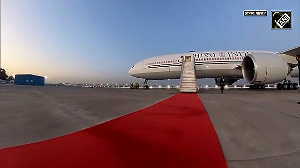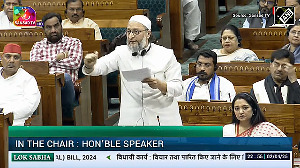The government has kick-started the funding of the mission to the moon, and has provided Rs 70 crore (Rs 700 million) in the Budget for 2004-05. The mission, including the launch of the lunar vehicle Chandrayan I in 2008, envisages an investment of around Rs 400 crore (Rs 4,000 million) over a five-year period.
India's moon mission aims to search for minerals and chemicals on the lunar surface through the mapping of the poles and craters, searching for surface or sub-surface water-ice and identifying chemical end members of high-land rocks, among other things.
Work on the launch has already started and Indian Space Research Organisation, in its first Announcement of Opportunity, has called for proposals for providing "suitable scientific payloads", including Terrain Mapping Cameras (TMC), Hyper-Spectral Imager and Lunar Laser Ranging Instrument.
While the TMC will be used to generate high-resolution three-dimensional cartographic map of the moon using stereoscopic cameras, the Hyper-Spectral Imager will obtain spectrum information by acquiring image data for mineralogical mapping using a wedge filter and an area array detector to.
The Lunar Laser Ranging Instrument is used for providing ranging data for determining the accurate altitude of the spacecraft above the lunar surface.
Isro has already selected payloads for high-resolution remote sensing of the lunar surface features in visible, near infrared, X-ray and low-energy gamma ray regions.
Proposals have been sought for sourcing about 10 kg payload weight and 10 watt power.
The mission, with an operational life of around 2 years, envisages placing a 525-kg satellite in a polar orbit, 100-km above the moon. The lunar vehicle is proposed to go round the two poles of the moon.
Chandrayan-1 was expected to be the forerunner of more ambitious planetary missions later, including landing robots on the moon and visits by Indian spacecraft to other planets in the solar system, Isro said.
India's mission to the moon was announced by Prime Minister Atal Bihari Vajpayee on Independence Day. Chandrayan I is proposed to be a 1.5-metre cuboid satellite with a launch speed of 10 km per second into an earthly orbit for a 350,000 kilometre journey in five and a half days.
In the Budget estimates for 2004-05, the government has also allocated Rs 490 crore (Rs 4,900 million), against Rs 250 crore (Rs 2,500 million) for this fiscal, for GSLV Mk-III development which is a launch vehicle capable to launching 4 tonne class of communication satellites.
The project is estimated to cost Rs 2,498 crore (Rs 24.98 billion) and will be completed in 2007-08.






 © 2025
© 2025